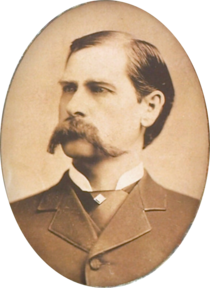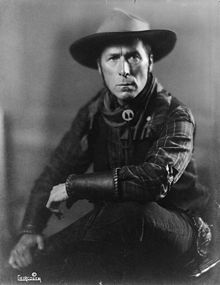1/13/1929 - One of the epic lives in American history comes to a quiet end in Los Angeles, California, with the passing of 80-year-old Wyatt Berry Stapp Earp.

Wyatt Earp - At About 39 Years
Born to Nicholas Porter Earp and his second wife, Virginia Ann Cooksey, in Monmouth, Illinois, in 1848, Wyatt is named after his father's commanding officer in the Mexican-American War, Captain Wyatt Berry Stapp of the 2nd Company Illinois Mounted Volunteers. Growing up, Wyatt receives lessons in responsibilities tending to the family's 80 acres of corn near Pella, Iowa. Then, in 1865, his wanderings through the American West begin with a wagon train journey to California.

Wyatt And His Mother - 1856

Boyhood Home - Pella, Iowa
Adventure to adventure, at 17, Wyatt is a teamster transporting cargo to Salt Lake City by way of a route moving through the beach town of Wilmington, San Bernadino county, and the small town of Las Vegas, Nevada. In 1868, he transports supplies to men working on the Union Pacific Railroad, and reputation gained for fairness, he begins officiating boxing matches in the Wyoming Territory. 1868 is also the year he becomes involved in law enforcement for the first time, becoming a constable in Lamar, Missouri (helped out by his father being the area's justice of the peace). Gainfully employed and surrounded by family, believing he is putting down roots, Wyatt marries Urilla Sutherland in 1870 (her parents own the town's Exchange Hotel), but tragically, his pregnant bride dies later that same year.

Urilla

Wyatt - 21
Devastated by the turn his life has taken, for awhile Wyatt's actions are off kilter and out of control, and include facing theft and forgery charges, accusations of horse stealing, an escape from the jail in Peoria, Illinois (climbing out through the roof), drunk and disorderly conduct, running a brothel, and serving as a bouncer for the cat house his brother James is running in the cow town of Wichita, Kansas. And it is Wichita where Wyatt will regain control of his life (it is during this period in his life that he also dabbles in being a buffalo hunter).

Wichita, Kansas
In 1875, Wyatt becomes a member of the Wichita marshal's office ... and also deals faro at the town's Long Branch Saloon. Fired for getting in a fist fight with the town's former marshal, Bill Smith, over an upcoming election, Wyatt is next off to Dodge City, Kansas, where brother James is once more in the brothel business ... there, Wyatt is appointed an assistant town marshal (he also takes time off to explore business opportunities to be found in the boomtown of Deadwood in the Dakota Territory) and meets some of the characters who will spice up his story ... folks like gunfighter John Henry "Doc" Holliday, Holliday's common-law wife, Mary Katherine Horoney Cummings, better known as Big Nose Kate, the Masterson brothers, James and Bat, gunfighter Luke Short, and prostitute Celia Anne "Mattie" Blaylock, who will become Wyatt's common-law wife.


Holliday & Big Nose Kate


James & Bat Masterson


Short & Blaylock
On 7/26/1878, Wyatt kills his first man when he shoots George Hoy off the cowboy's horse as the man drunkenly attempts to shoot up one of Dodge City's entertainment establishments (a leg wound, gangrene sets in and Hoy dies on August 21st after the limb is amputated), the Comique Theater. Relocation time again, in 1879, Wyatt decides to lend a helping hand to his brothers' Arizona business efforts, resigns his marshaling job, and moves to the new, and wild, mining town of Tombstone. In Tombstone, the Earps stake mining claims and file papers for water rights, James works as a bar tender, Wyatt becomes a shotgun messenger for Wells Fargo, and Virgil is the town constable of nearby Prescott. Shortly afterwards, Doc Holliday and younger brothers Morgan and Warren show up in town too. Involved in the growing community, it does not take long before the Earps and friends tangle with the local criminal element, a batch of rustlers, thieves, and killer gunmen that call themselves "The Cowboys."

Tombstone - 1881


Morgan & Virgil
Over the next year, there will be confrontations with cowboys over rustled horses and cattle, Wyatt will be appointed Deputy Sheriff of Pima County (which includes the town of Tombstone), he will pistol whip Curly Bill Brocius after the drunken gunman accidentally kills Tombstone town marshal Fred White, a prize horse stolen from Wyatt is discovered in the possession of Ike Clanton and his brother Billy, Earp and Cowboy supporter Cochise County sheriff Johnny Behan share the bed of 18-year-old Josephine Sarah Marcus (who will eventually become Wyatt's common-law wife), Wyatt gains a one-quarter interest in the faro games at the Oriental Saloon (for which he serves as a manager and enforcer), stands down a mob intent on lynching gambler Michael O'Rourke for the killing of mining engineer Henry Schneider, serves on the posse that chases after the silver bullion robbers that kill stagecoach driver Eli "Budd" Philpot and passenger Peter Roerig, and serves on the posse that arrests Cowboy favorites, Deputy Sheriff Pete Spence and Deputy Sheriff Frank Stilwell after the lawmen rob a stagecoach outside of the town of Bisbee. In October the troubles between the two groups boil over in 30 seconds of mad gunfire that will come to be called the "Gunfight at the OK Corral."

Josephine Earp

Curly Bill
An argument between Ike Clanton and Doc Holliday, an argument between Ike Clanton with Wyatt, Virgil pistol whips Ike when the drunken cowboy refuses to give up his weapon, Ike and Wyatt threaten each other, Wyatt pistol whips Cowboy Tom McLaury for carrying a concealed weapon, and the Earps seeking to confiscate even more Cowboy weapons leads to the 3:00 in the afternoon gunfight for Tombstone city dominance. Representing the town's law and order faction are Town Marshal Virgil Earp, Assistant Town Marshal Morgan Earp, Deputy Marshal Wyatt Earp, and temporary Deputy Marshal Doc Holliday, while representing the area's rowdier elements are Cowboys Billy Claiborne, Ike and Billy Clanton, and Tom and Frank McLaury (28 and 33 respectively). Asked by Virgil to give up their weapons as the Cowboys stand in a narrow lot to the side of C. S. Fly's Photographic Studio, six doors west of the rear entrance of the OK Corral (the men are between six to ten feet away from each other), someone instead draws their pistol and fires, and general firing breaks out among the men ... when the bullets stop flying and the smoke settles, Billy Clanton (19) and the McLaury brothers are dead (Billy Claiborne and Ike Clanton flee the area), Morgan Earp suffers wounds to both shoulder blades, Virgil Earp is shot in the calf, and Doc Holliday suffers a flesh wound to his hip. Only Wyatt emerges from the gun battle unhurt.

Gunfight

L-R ... Tom McLaury, Frank McLaury, and Billy Clanton

Tombstone Boot Hill
Legend established, the gun battle however does not end the killings between the two factions ... in the days and months ahead, Virgil Earp is ambushed and made into a cripple by a shotgun blast to his left arm, Morgan Earp is killed by an assassin's bullet while playing billiards, Wyatt kills Frank Stillwell at the Tucson train station as the man prepares to fire on the Earp Family leaving town, and Earp leads a posse of supporters against the Cowboys that includes his brothers Warren and James, Doc Holliday, Sherman McMaster, Jack "Turkey Creek" Johnson, Charles "Harelip Charlie" Smith, Dan Tipton, and John "Texas Jack" Vermillion. When the Earp group finally vacates the Arizona region, the power of the Cowboys is broken, and Florentino "Indian Charlie" Cruz, Curly Bill Brocius, Johnny Barnes, and Johnny Ringo are all bullet riddled corpses that die with their boots on!


Ringo & Stillwater
Vendetta ride over, Wyatt will deal faro in Bat Masterson's saloon in Trinidad, Colorado, reunite with Josephine Marcus in San Francisco in 1882 (they will remain together until Wyatt's death 46 years later), gamble and try mining in Silverton, Colorado, help Bat Masterson and Luke Short keep their saloon open in what will be called the Dodge City War, goes mining in Idaho (where he will also be a Deputy Sheriff) and Washington, speculates on San Diego real estate, referees boxing matches, buys four saloons, races a horse named "Otto Rex," owns a horse stable in Santa Rosa, California, referees the heavyweight champonship match between Bob Fitzsimmons and Tom Sharkey (a match that Earp is accused of fixing for calling a punch foul that no one else sees), participates in the Klondike Gold Rush, runs the Dexter Saloon in Nome, Alaska, runs a saloon and gambling house in Seattle, goes gold hunting in Tonopah, Nevada (where he opens yet another drinking establishment that he names the Northern Saloon), at 62, works "outside the law" tracking down miscreants for the L.A. Police Department, works a San Bernadino site in the Whipple Mountains he calls the Happy Days mine, collaborates with John Flood and Stuart Lake on biographies, and lends his western expertise to a number of silent Hollywood filmmakers (he will become good pals with directors Raoul Walsh and John Ford, and actors Douglas Fairbanks, William S. Hart, and Tom Mix).


Fitzsimmons & Sharkey

William S. Hart

Wyatt In 1923
A full life, chronic cystitis does what no bullet can, and the former lawman passes on 1/13/1929 ... cremated, his remains are buried in a secret spot in Colma, California. Rest in peace, Wyatt!

Wyatt


































